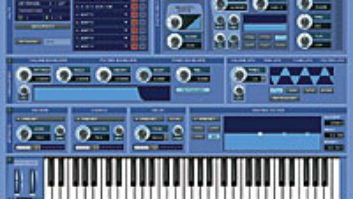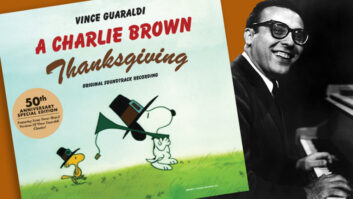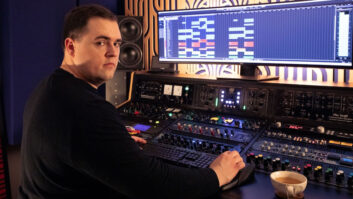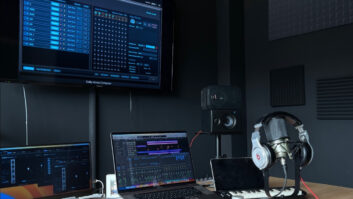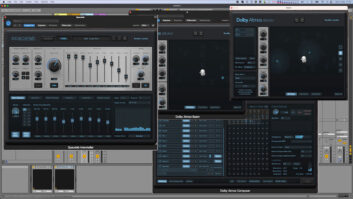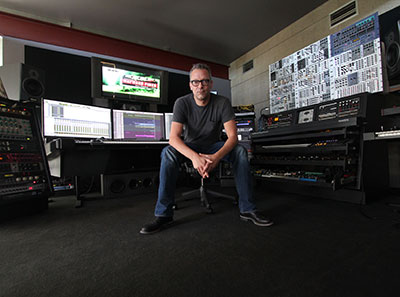
Dear TC Electronic, on behalf of award-winning composer Charlie Clouser—former Nine Inch Nails keyboardist who’s gone on to score the entire Saw film franchise—we respectfully request a reissue of his favorite compressor/limiter plug-in, the Master X5. For years Master X5 has been an integral part of his sound for TV scores, but since updating to a new Apple Mac Pro, the TC Electronic PowerCore is no longer compatible with his system. Clouser, who is currently scoring his second season of Fox Network’s series Wayward Pines, says, “There is something about the way in which the Master X5 can step on the signal, bring up the level of my quiet little sounds without inducing artifacts and pumping. That plug-in is the sound of my TV music and I’m limping along without it. I would be very happy to see the Master X5 make a return in some form.”
Nearly 15 years ago, Clouser’s TV scoring days were filled with procedural crime dramas that only required a stereo music mix for each episode. But recently, Clouser has noticed the film ethos infiltrating the TV mentality via limited-run network series like Wayward Pines, streaming series like Netflix’s ambitious Marco Polo, and souped-up premium cable series like HBO’s Game of Thrones. There’s a growing trend to treat episodic content like extended movies parceled into one-hour packages.
“The production brief now is, ‘We’re not making a TV series. We’re making a miniature movie split into 10 parts,’” he says. “You see on the visual side, from shows like Game of Thrones to American Horror Story, that they have a much higher production value, and that has trickled down to the music and sound side. That has definitely changed my approach to the score.”
One big change is the delivery requirement. Stereo music mixdowns? Not anymore. Clouser now delivers full surround stems on certain shows, which is also a typical delivery for film. He says, “I’m delivering many more stems than I was at the beginning of my career.”
There is a difference though, between the stems he creates for TV scores versus the stems he generates for film. Clouser explains that the music for TV tends to be less dynamic and more compressed in terms of its dynamic range. Going back to the importance of his beloved Master X5 plug-in—a five-band virtual version of TC Electronic’s Finalizer hardware unit—Clouser needs compression to help his delicately bowed waterphones and metal sculptures, and quiet bowed guitar sounds stand up to huge car crashes and blazing gun battles in the mix. “I’m often using sounds that are very quiet at their source, which have to be amplified and compressed just to sound loud. I have to boost the heck out of them to make them audible over the mayhem on-screen,” says Clouser, who’s become a connoisseur of mastering plug-ins in his search for a Master X5 replacement. He’s currently using Waves L3 Multimaximizer and iZotope’s Ozone 7 mastering software.
Another way film sensibilities have spread to TV scores is in dealing with the story arc. For example, Wayward Pines tells a story that develops over a 10-hour time-span, whereas a more traditional series, like The Simpsons, treats each episode as a stand-alone story. In a typical film, a story arc is roughly two hours, but in this film-style series, the story arc spans 10 hours. Wayward Pines starts off Season 1 with a small, creepy town, but by the season finale, the series morphs into a creature-feature. How does the composer account for a 10-hour story arc?
“Fortunately, you can think of it as one big story arc with each episode being a little bump,” Clouser says. “Some of the creepy, more subtle musical elements I created for the early episodes faded into the background as the storyline got more intense. Those creepy, quieter elements became a backdrop to which the score would fall when the action subsided. I didn’t actually walk away from whole chunks of the approach to the score as the series developed, but the proportions kind of changed.”
Some of the subtle, creepy tones Clouser carried over to Season 2 were bowed metals and quiet bits of guitar feedback. While those are no longer the lead sounds, they are still part of the show’s musical flavor. “Many of the melodic themes and chord progressions I came up with for the first few episodes of Season 1 have become the pattern by which more elaborate cues are developed for this second season,” he explains. “Everything still fits in the same harmonic and chordal space.” He also wrote Wayward Pines’ main melodic theme, which has melodic and harmonic elements that became the map for the chord voicings he uses for the rest of the score. “I was using this little three-note melody that became a signature piece. There were a lot of happy accidents that resulted in early episodes providing raw material that could populate later episodes, even if those later episodes were stylistically more intense.”

Photo: Zoe Wiseman
On Season 2, Clouser scores epic battles between Army troops and hordes of creatures trying to scale the town’s wall. These big scenes call for more than what the quiet tension of bowed metals could provide, so Clouser breaks out the war drums, big low brass and strings—more conventional orchestral sounds that have power and heft. “I’m adding music elements that are big, huge and splashy, but I’m still keeping the chord structures and melodic structures true to what was created for the creepy vibe of the first few episodes of the first season,” he says.
Nearly all of the orchestral elements for Clouser’s TV scores come from virtual sources. And while he has numerous new sample libraries, he is not shy about utilizing older sample libraries, like the early EastWest Platinum Orchestra library, the Denny Jaeger sample library originally created for the Synclavier, and libraries from Kirk Hunter Studios, which according to Clouser are one of the earliest providers of deeply sampled orchestral instruments. These older libraries might lack features found in newer libraries, like multiple mic positions or true legato, but they have a certain sound that fits what Clouser hears in his head.
“The sound of the recordings, and the players, and the instruments that were captured in those older libraries, often sound darker and thicker to me, and seem to mesh better with other sounds in my palette,” he says. “It’s just like with vintage outboard gear and microphones—they have a certain sound and I understand why people to go to great lengths to have Fairchilds and Pultecs in their racks. I seem to do the same thing with sample libraries.”
When it comes to more delicate passages, such as those for solo cello or GuitarViol (a cello-guitar hybrid handcrafted by TogaMan Guitars), Clouser likes to perform those live. “Like many composers, I find that it’s easier to get gigantic, epic sounds from in-the-box orchestral simulations than it is to get delicate, exposed solo instrument passages,” he says. As for that GuitarViol, Clouser explains, “It has a guitar fretboard but an arched bridge of a cello and it’s played with a bow. It allows people who can work a guitar fretboard but maybe not a cello fretboard to achieve cello-like sounds and playing techniques.”
In addition to TV series, Clouser also composes for film, notably the aforementioned Saw franchise and Resident Evil: Extinction. For the upcoming horror film The Neighbor directed by Marcus Dunstan (screenwriter for Saw IV and Saw V), Clouser chose a non-orchestral approach. The film takes place in rural Mississippi, so Clouser wanted “a sound palette that fit the setting of the story. Guitar seemed like a natural choice.” He did much of The Neighbor’s score work with Parker Guitar’s Adrian Belew’s Signature MaxxFly guitar. “Parker guitars are unusual and strange instruments anyway, but their Adrian Belew Signature model is a super hot-rod version. It has a Sustainiac sustainer pickup in it, as well as the sound modeling engine from the Line 6 Variax modeling guitars.”
With the Line 6 Variax modeling technology, Clouser can use the same guitar to make unlimited new sounds. For example, he can start with a steel-string acoustic guitar simulation and then use the software engine to individually pitch shift the strings an octave in either direction. “A lot of happy accidents can come from fiddling with the settings on a modeling guitar. I don’t see them used much among my contemporaries, but I think that they are an invaluable tool for getting a wider spectrum of tones that I can coax just out of my Les Pauls, for instance.”
For both film and series scores, Clouser composes in Apple’s Logic 10 and uses a Pro Tools 11 setup on a separate Mac Pro as his stem recorder, for easy delivery to the dub stages, which generally have Pro Tools-based workflows. His studio, located in Topanga, Calif., has 5.1 surround monitoring via a Dynaudio Air System. Clouser says, “I was very disappointed to learn that system was recently discontinued. Fortunately, I have two complete 5.1 sets and a variety of stereo sets. It’s a lifetime supply, but still they are really my favorites.”
Although his approach to mixing and mastering film scores is different from his TV score approach, Clouser still uses many of the same in-the-box processing plug-ins, like tools from UAD and Waves, particularly Waves’ signature series offerings like the Jack Joseph Puig and Manny Marroquin bundles.
“I use some of the signature series plug-ins, originally meant for rhythm guitar and backing vocals, on sounds like weird, bowed metal instruments that might need some harmonic excitement or stereo widening but not a chorus or flange,” he explains. “I’ve also gotten really great results from the Steven Slate plug-ins, mostly the virtual rack plug-in into which you can insert various EQ and compressor modules. Some of those have been quite surprising in terms of the heft and girth that they can add to a sound.”

